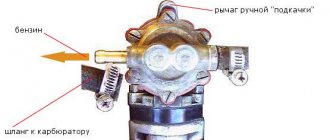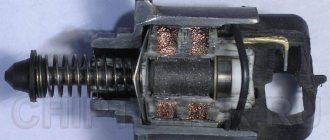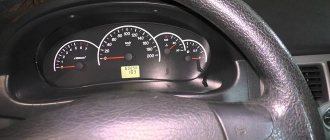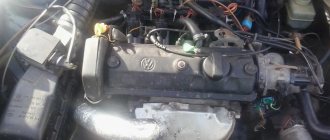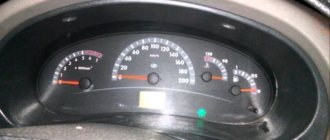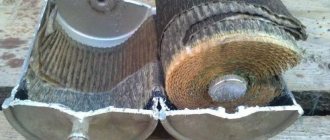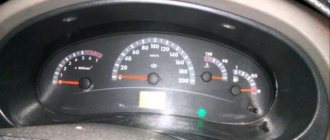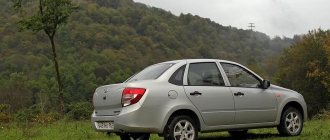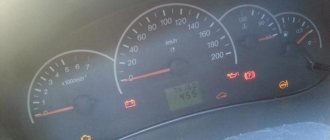More than once, Lada Kalina car owners have encountered the concept of a car starting up and immediately stalling. There are few reasons for this phenomenon, but they can create discomfort, and the car may simply not start at the most necessary moment.
Video with a solution to the “double start” problem on the Lada Kalina (starts and immediately stalls):
The video material will tell you why Kalina starts and immediately stalls, the causes of the malfunction and methods for eliminating it
What to do first
You should start, oddly enough, by checking the presence of fuel in the gas tank, and you should also make sure that the anti-theft system is turned off.
It is possible that you were mistaken for a car thief. These are the simplest solutions to the problem, but unfortunately, they are also the rarest. Next, if the car continues to stall immediately after you start it, check to see if the fuel tank pump is working. To do this, put someone behind the wheel, open the tank cap, and ask an assistant to turn on the ignition without starting the engine. In the first seconds after turning on the ignition, you should hear the pump running. If you don't hear it, the pump may be faulty. It’s also worth checking the fuel filter, especially if you haven’t changed it in a while.
In addition, an air bubble in the fuel system may cause the engine to spontaneously stop immediately after starting. And solving this problem is much more difficult. Often you have to push the car or tow it in order for the engine to start. But all this is possible only for cars with a manual transmission.
Main reasons
The engine does not start the first time
Kalina has a fairly common reason that it does not start the first time. This is due to design, wear and tear and electrical issues. But, it is worth breaking the problems into categories and considering them in more detail. So, let's look at the main categories into which this malfunction is divided:
- Problem with the fuel system.
- The reason is the ignition.
- Failure of timing elements.
- The problem is in the operation of electrical circuits and the ECU.
Fuel system
The first reason that a car may not start the first time is the fuel system. Insufficient fuel or too much gasoline becomes a problem. In this case, the starter turns, but starting is difficult. If the starter does not turn and the immobilizer icon is flashing, then the problem is already on the immobilizer side.
Fuel pump wear
A failure of the fuel pump or a clogged fuel filter can cause the pressure in the fuel line to be insufficient and the mixture to be lean. Accordingly, the small amount of fuel in the combustion chambers is not enough to start the engine. If too much fuel mixture is supplied, the spark plugs are simply thrown and there is no spark to ignite, which causes the engine to not start.
Ignition
The second reason for poor starting is a malfunction of the ignition system. The problem may lie in the following nodes:
- Ignition switch malfunction.
- Breakdown in high-voltage wires.
- Spark plugs are worn out or dirty.
Next, you need to check the ignition wires, resistance and insulation damage. If necessary, it is worth replacing failed products.
Wear or damage to high-voltage wiring is accompanied by poor resistance
Gas distribution mechanism
You can often find in manuals that starting not the first time is associated with incorrect operation of the gas distribution mechanism. First of all, this is due to carbon deposits that form on the valves, as well as incorrect operation of the gas distribution phases. The malfunction should be looked for in the camshafts, as well as the position of the crankshaft relative to the camshaft.
Another reason could be wear on the timing belt and pulley. A stretched belt can disrupt valve timing. It is worth checking and, if necessary, installing a new timing belt repair kit.
Correct location of timing marks; if it does not correspond to the picture, then this is the reason for poor engine starting
Electrics
The last reason why such a malfunction may occur is electrical parts and circuits. So, the problem may lie in the starter, electronic control unit or wiring. We discard the main cause of the battery, because if it is dead, then the car will not start the second time. Let's consider all the reasons separately.
Starter
Problems in the operation and failure of the elements of this unit can cause a poor start.
Starter device
Wiring
Breakdowns and problems in the wiring can cause the car to not start the first time. So, you should look for a problem between the battery terminals and the starter, as well as the ignition coil and spark plugs.
Carbon deposits on spark plugs can cause poor engine starting.
ECU
The electronic control unit can be the main reason why the car does not want to start the first time. Thus, a large number of errors can lead to the issuance of incorrect commands. For example, incorrect amount of fuel distributed or mixture enrichment. It’s worth getting into the ECU after the fuel system, ignition and starter have been checked. The cause is eliminated by resetting errors or changing the firmware.
Electronic control unit errors
Ignition and spark plugs
An incorrectly set ignition timing can cause the engine to stall, including stalling immediately after starting. But ignition is a problem that manifests itself in any mode of engine operation. The engine will shoot, sneeze, malfunction and trip, in general, it will not work stably. Therefore, problems with the ignition system most likely will not be able to take you by surprise.
By refusing to work immediately after starting, the car may subtly hint to you that it is time to replace the spark plugs. True, in this case, failures and other violations will appear in other operating modes.
Due to a clogged injector, the car can also start and immediately stall. It is better to clean the injector by dismantling it and mechanically cleaning it. The fact is that the chemistry used for such purposes can dissolve the dirt and soot that clogged the injector, but does not remove them. And even the designer of this engine will not tell you where this very dirt will end up.
In rare cases, a completely clogged air filter can cause similar symptoms. But this is rather an exception, and checking it is not so difficult. Just run the engine for a minute without the air filter.
The VAZ Kalina stalls 2-4 seconds after starting
VAZ (Lada) Kalina 2004 - 2013
When starting the car, it stalls after 2-4 seconds. After resetting the controller with BK-State, it works perfectly. Until the next start. There are no errors. Sometimes there is a “rich mixture”.
- Kalina takes a long time to start - 3 answers
- In the morning it works for 2-3 seconds and then stalls, Kalina - 2 answers
- It revs itself in the morning at idle, Kalina – 6 answers
- The idle speed on the VAZ Kalina jumped up - 6 answers
- VAZ Kalina stalls when cold or in the cold - 5 answers
Well, here is only the correct diagnosis. And obviously not by the State.
I would generally recommend that you disable this BC; there was a case when, thanks to the STATE, I had to change the ECU. Disable it and try without it.
Electronic components
Perhaps the most common reason that a car starts and immediately stalls is the failure of the idle air regulator or IAC. But it is not always necessary to immediately change the IAC; in some cases, oxidation of contacts and other completely removable problems occur. However, the failure of the idle air control valve is usually not indicated on the dashboard and the Check Engine light does not light up either. You can determine that the problem is in this particular unit by the floating speed in idle mode.
In addition, the following sensors can create problems with the operation of the motor immediately after it starts:
More precisely, problems arise due to the failure or malfunction of one of these sensors. And of course, problems with the electronic engine control unit can cause the car to stall immediately after starting. As a rule, to troubleshoot problems in electronic systems and components of a car, you will need the help of a qualified specialist. Because, in addition to correctly carried out replacement, a number of electronic components may require some adjustments, calibration and other preparatory procedures.
When the throttle and crankshaft position sensors fail, the Check Engine indicator usually comes on.
Unfortunately, faults in car electronics are difficult to repair on your own. Moreover, it is not always and not always easy to find a specialist who is able to quickly and, most importantly, correctly determine the cause of a car breakdown and eliminate it just as quickly and efficiently.
Main causes of malfunction
What to do if you cannot start the Lada Kalina engine when the starter is turning
If we consider the issue from the technical service side, they will immediately say that the immobilizer has failed, but everything is not so simple. It may be not only about the security robot, but also about other things.
So, it is worth considering the main reasons for this malfunction:
- Clogged fuel nozzles - nozzles.
Examples of different operation of injectors for Kalina
Fuel pump, which may cause Kalina to not start
The spark plugs have been removed from the vehicle to be inspected.
All these reasons will lead to the fact that the engine will not start, but the starter will turn.
Does not start? Let's consider elimination methods
So, it’s worth sequentially looking at the actions that will help normalize the operation of the motor. But before that, you should prepare. So, what tools will be useful: a tester, a set of keys and wrenches.
Now that you are armed with everything you need, you can get to work:
- We remove the fuse panel and check the integrity of individual elements. On the back of the cover it is written which safety element is responsible for what. We find the fuses responsible for: starter, battery, immobilizer, fuel pump and ignition coil. All of them must be checked for functionality.
Kalina fuse box, where to look for the problem
If none of the checks yielded results, then you should prepare for the worst.
The worst thing that can happen
You shouldn’t be so scared of what you might find, but most likely one of the following problems has arisen on Kalina:
- The starter bendix has failed.
- The problem is in the valves, which could be stuck.
- Worn piston group or oil scraper rings.
Replacing the starter bendix
On all Lada models, one of the common reasons that the engine does not start when the starter is working is bendix. It is not advisable to repair this part, so it is worth replacing it, since it costs pennies.
So, let's look at the step-by-step instructions for replacing the Bendix on the Lada Kalina:
- We dismantle the starter. To do this, disconnect the “minus terminal” from the battery. Unscrew the nuts securing the power supply wires and unscrew the fastening bolts.
- We dismantle the retractor unit.
Unscrew the retractor assembly from the stator relay
Unscrew the retractor group with the relay
Using a screwdriver, remove the retaining ring holding the bendix.
We remove the bendix from the Kalina stator
Malfunctions in the intake system
This refers to the air filter, intake manifold, and throttle valve. The first of the listed elements has the “property” of becoming clogged with dust and dirt over time. As a result, the engine receives a mixture in which there is little air (or no air at all) and the engine stops working immediately after starting.
As for the throttle valve, it makes sense to check the normal operation of the sensor that controls its position. Clogged intake lines are a rare occurrence and are usually associated with a poor air filter allowing contaminants to pass through.
Ineffective generator operation. the engine does not have enough energy
The first reason that leads to constant attenuation of the motor under certain loads. non-functioning, in other words, a poorly functioning generator. As long as your car's battery is working perfectly, you won't notice any negative effects. But when the battery runs out a little, the engine simply won’t have enough charge. Therefore, it is possible that the engine will simply stall due to lack of electricity to carry out the work of a complex of accounting management programs. The main features of this problem are the following:
- when you turn on certain equipment in the car connected to the electrical network, the engine stalls due to lack of charge;
- the on-board vehicle begins to malfunction due to constant power fluctuations and other internal problems;
- The car stalls when you try to apply a certain load and press the accelerator pedal. it is also related to electricity;
- the generator makes certain sounds, the belt rotates and does not even provide normal electricity generation;
- When you press the accelerator pedal, you see that the headlights, in other words, the interior lighting, become brighter. this is a sign of a lack of electricity;
- The on-board driver begins to lead such a life in an incomprehensible way, does not perform the necessary functions, and produces errors.
This, there is no guarantee that this problem will be associated with a missing charge of electricity, no matter how annoying it may sound, owners of various models and brands of cars often encounter such difficulties. Therefore, it is much more reliable to perform high-quality diagnostics of all parts of equipment and peripheral units, such as a generator. Typically, these components, however, influence various problems and inappropriate behavior of the machine. For example, they can cause problems such as the engine stalling immediately after starting.
KEY-DOP
Fuel level sensors in the gas tank. They are not the most reliable element of a car, so they often become unusable and require replacement. Poor fuel, difficult climate. all of the above can damage the sensor. Also, constant refilling of fuel to a certain displacement does not bring anything good. Many people have the habit of filling up with 20 liters. who once. The sensor is worn out here and there and is simply not able to work perfectly.
If you did not follow the sensor readings, it turned out that there is no fuel in the car; it is possible that the car may behave in such a way that the engine constantly stalls, and eventually stops starting completely. If such a problem occurs, immediately add a few
l. fuel and see if the car's behavior changes. Remember that long attempts to start the unit without gasoline in the tank will be fraught with unpleasant consequences. The fuel pump may overheat and fail.
Fuel and its quality
The banal lack of fuel in the tank is one of the reasons why the engine stops working immediately after starting. The fact is that the fuel pump begins to “grab” air and the engine stalls. This situation can also occur when there is fuel (5-7 liters) and the car is parked on a slope. Sometimes the reason why the power unit stops working after starting is water getting into the tank or low-quality fuel.
Diesel engines have their own nuance: using diesel fuel that does not correspond to the season - as a result, in winter, summer fuel will crystallize. In all cases, you will have to completely pump out the fuel and fill in new fuel: high-quality and appropriate for the time of year.
The next step is to check the functionality of the fuel pump. To do this, screw on the gas cap and have an assistant turn on the ignition. A running pump will make a characteristic sound: in some car models it can also be heard in the cabin. However, the buzzing of the device’s motor does not mean that it is fully operational. Often the reason for the lack of fuel in the combustion chamber lies in a clogged fuel pump filter mesh. To clean it, remove the device (usually it is located under the rear seat). If the car still stalls, it is worth checking the fuel filter (there are two of them: fine and coarse) and the injectors for clogging.
Symptoms of a problem
- The first sign indicating a breakdown of the fuel pump will be a banal refusal of the engine to start. Of course, such an indicator as an unstarted car is very general. In this case, it is worth checking the spark plugs, which may become oily and not produce a spark and the ECU.
- The second point is the pressure of the fuel system. If the fuel pump is OK, it creates a pressure of 3.2 bar. The fuel rail is characterized by the following indicators:
- for a volume of 1.5 l – from 285 to 325 kPa,
- for a volume of 1.6 l - from 375 to 390 kPa.
- A very common problem is when the signal does not reach the fuel pump after ignition. When you turn the key, you usually hear a slight vibration from the fuel pump, but here it doesn’t happen. Most likely the wiring has failed. We'll have to call her and figure out what's what.
- The engine is tripping. Like reason number one, this indicator is not a benchmark. It is believed that the signs of a malfunction of the VAZ 2114 fuel pump are represented by other obvious causes of malfunctions. However, if the fuel pump is not working properly, the engine begins to jerk (which is natural, fuel combustion in the cylinders occurs incorrectly), and operate intermittently out of the blue.
- The engine may jerk even before starting or at low speeds. This reason is closer to the truth: either the fuel pump or its mesh – a low-purity filter – is not working.
The fuel module, which includes the pump itself, is expensive - from 2,000 to 3,000 rubles. The inept owners of the fourteenth buy it entirely (together with the filter, fuel level sensor, float and intake chamber) and install it to replace the deceased.
In fact, the price of a VAZ 2114 fuel pump is only 700-1000 rubles, you only need to take and install it, the rest of the module almost always remains intact.
Just don’t immediately run to the spare parts store and buy a new one! There are plenty of reasons for the breakdown, including those that may lie in the power system. Here are the main ones:
- Fuel pump fuse VAZ 2114
- Fuel pump relay VAZ 2114
- Poorly secured mass of the VAZ 2114 fuel pump
- Fuel pump motor VAZ 2114
- Contacts of the fuel pump system VAZ 2114
- The fuel pump itself
We recommend: Fuel pressure regulator VAZ 2114
All these spare parts can break and stop the normal operation of the fuel module system. In fact, the fuel pump is the part of the fuel system that passes gasoline under pressure. The mechanism is complicated, we will understand it step by step.
The car stalls when you press the brakes and change gears
In the first case, the reason is obvious: a malfunction of the vacuum brake booster, which is responsible for supplying air to the intake manifold. If this happens improperly, the fuel mixture is not in the correct proportion and the car stalls. To be sure that the amplifier has failed:
- remove the hose connected to the manifold;
- plug the vacated hole with a suitable bolt;
- start the engine: if the situation has not changed, change the vacuum booster.
Serious malfunctions of the gas distribution mechanism in a car
An additional, not the most pleasant option for this problem, when the engine starts and immediately stalls, is a malfunction of the valves in the internal combustion engine, also called a decrease in fuel pressure in a diesel unit and an injection gasoline version of the equipment. First you need to contact a service station to inspect the valves, their options, and, of course, diagnose the gas distribution mechanism. For example, on a Toyota, the cause of the problem will be VVT-i, which, given our quality of gasoline, often burns out. The following difficulties occur:
KEY-DOP
- the valves need to be adjusted, the gaps are uneven, which interferes with the normal operation of the engine;
- one, as it is also called several
valves are deformed, they will need to be replaced with the following diagnostics and adjustment of the mechanism; - the on-board diagnostic system caused severe problems and blocked access of fuel to the combustion chambers;
- the car is overcooled, it does not have enough injector power for normal warm-up at start-up;
- Diesel fuel froze in the fuel pipes, turning into a jelly-like mass, which created certain difficulties.
In each situation, a variety of problems are likely, which can only be solved by professionals at a service station. In general, many manage to resolve all issues quite easily and perfectly without the help of others. It may be that you just need to let the car warm up in the garage, or in other words, on a warm daytime, so that what remains to be done for our client, allowing the accounting (software) to work properly, does not force the owner of the car to pay exorbitant amounts of money for the restoration of the equipment.
Other reasons for stopping the engine immediately after starting
Often the engine stalls after starting due to failures of the alarm system and anti-theft electronics. To put it simply, the immobilizer blocks the operation of the internal combustion engine, “considering” that this is a theft, that is, an unauthorized attempt to start the power unit. If the reason is the alarm, then try resetting the electronics error or disabling the anti-theft.
Every car enthusiast may encounter a problem when the car starts and stalls immediately after starting the engine. The driver's natural reaction will be to try to restart. As a rule, they do not lead to success and end with a complete discharge of the battery. The best thing to do when you notice your car is unable to maintain idle speed after starting is to find out the cause and fix the problem.
Lada Kalina starts and immediately stalls. Cause and solution to the problem.
I'm talking about a glitch with the Lada Kalina. Like a car that doesn’t want to start on a dead battery. The reason is the immobilizer. View to all Kalinovodas. A very scary situation. There is also a problem with starting it by lighting it from another car. Immobilizer lags on AvtoVAZ Lada Kalina.
Aidyn QazaQ Khany 6 개월전
like you friend. changed the battery and started.
Sasha Malina 6 개월전
I've been racking my brains for half a year, and here it's just you
Machinist 10 개월전
What the hell does this have to do with the battery? My battery was dead. After a day of standing, the starter could barely turn, but when it caught hold, it started and rumbled steadily. Now there is another grant, the starter turns vigorously even after a week of standing. But with the onset of cold weather, glitches began when cold - it starts, rumbles for 1-2 seconds and stalls, but the second time everything is ok. This is 100% not about Akuma. It seems to me that the dog has rummaged around with one of the relays, the gasoline relay is surrendering to me. This is due to a power loss during startup, causing the relay to turn off the fuel pump.
Machinist 8 개월전
Mikhail Velikorodny is good.
Mikhail Velikorodny 8 개월전
Driver I have the same problem! If you find a way, let me know! Thank you in advance !
777jj555zlo
100% right!! low voltage and the standard emobilizer will work, it turns off or prevents the car from starting, clean the ground on the contact body, lubricate the terminals, charge the battery
SEARCH ENGINE 63RU
did you try to start it in emergency mode? so at least you can get home)
Primary diagnosis
When you turn the ignition key or press the Start button, the electrical system, consisting of a starter and battery, turns the engine shaft. Once the engine starts, it requires a constant flow of gasoline and a good spark to maintain combustion cycles. If there is not enough fuel entering the cylinders or there is not enough spark, the car will stall.
More modern vehicles are equipped with sophisticated computers that control all engine processes. These computers improve engine efficiency, but can force the engine to shut down if they detect any faulty systems.
Cars of older models are not so complex and, as a rule, easier to diagnose than modern ones, but on-board computers can provide information about the operation of the systems when a code scanner is connected.
The best place to start diagnosing why a car starts and then stalls is to identify the conditions under which the engine stalls, so you can then focus on the systems or components associated with failure within that specific condition. An unsuccessful start can occur under only one operating condition or several at once. For example, the engine stalls:
- immediately after launch;
- some time later;
- after a long stay;
- on a warm car;
- under any circumstances.
Conditions associated with the problem can provide clues as to which systems or components need repair. Regardless of whether the engine stops immediately after starting or the car starts and stalls after a few seconds. The cause of the malfunction may be:
- ignition or injection system;
- idle speed adjustment;
- carburetor or injector;
- depressurization of fuel or air lines;
- one or more sensors.
Eliminating air leaks
Air leaks are another common cause of difficult engine starting. If you choke on air, or even stall, don’t even doubt it – it’s an air leak. You need to look for it in the following places:
- through the intake manifold gasket;
- vacuum booster;
- throttle valve gasket;
- adsorber valve;
Carefully check all these elements, as well as the condition of the seals. Go through all the air ducts, there may be damage somewhere. The vacuum system hoses must also be intact. You shouldn't forget about them. You can also use the following method: turn on the engine, let it run for a while, then walk around the car and listen in the hope of catching the sound characteristic of air leaking.
It will be sizzling. Next we clamp the hoses going to the intake manifold. After we have wrung out the hoses, we monitor the operation of the engine. If there are changes, it means there is leakage in the area of the vacuum booster and pressure regulator. In general, this problem is quite serious. requires a lot of time and perseverance. But he is quite capable of handling it himself.
Vikizzz
Participant
A problem that we cannot solve for a long time. Kalina, 1.4 engine with electronic throttle (Bosch ME17.9.7). In the morning when it's cold it starts hard. It starts up, and until it warms up to 50 degrees, when you press the gas, it starts to throttle and stalls. There is also a problem with the hot button, but not as much.
We changed the mass air flow sensor, DC valve, and fuel pump (pressure from 3.5 to 4). HBO is installed, but the problem disappears on gas! The engine responds adequately to the gas pedal! There is a suspicion about the injectors, but how can their operation be related to the temperature - more or less everything works when it’s hot. Anyone have any thoughts on this? Thank you in advance!
Participant
A problem that we cannot solve for a long time. Kalina, 1.4 engine with electronic throttle (Bosch ME17.9.7). In the morning when it's cold it starts hard. It starts up, and until it warms up to 50 degrees, when you press the gas, it starts to throttle and stalls. There is also a problem with the hot button, but not as much.
We changed the mass air flow sensor, DC valve, and fuel pump (pressure from 3.5 to 4). HBO is installed, but the problem disappears on gas! The engine responds adequately to the gas pedal! There is a suspicion about the injectors, but how can their operation be related to the temperature - more or less everything works when it’s hot. Anyone have any thoughts on this? Thank you in advance!
More than once, Lada Kalina car owners have encountered the concept of a car starting up and immediately stalling. There are few reasons for this phenomenon, but they can create discomfort, and the car may simply not start at the most necessary moment.
Video with a solution to the “double start” problem on the Lada Kalina (starts and immediately stalls):
Common Problems
The best way to start diagnosing is to read the fault codes stored in the on-board computer's memory. This can be done at the nearest service station or yourself. If you don’t have a scanner, then you should think about purchasing one. Such devices are now relatively inexpensive.
Owners of old VAZ models will not need it, but owners of Priora and modern foreign cars will significantly improve the quality of self-diagnosis of faults.
Fuel and starvation
It is better to start diagnosing the line with the fuel filter. Check the compliance of the intervals in the service book and operating manual, take into account the impact on its service life of refueling the car with low-quality fuel or in risky places. If possible, use a fuel pressure sensor to check the circulation in the line. If the filter is clogged, it will need to be replaced. Likewise, an imbalance in the proportions of fuel and air caused by contamination of the injector or carburetor can cause the engine to stall at idle.
A large share of this type of problem is related to the fuel pump relay. This component affects the operation of the pump in the same way as a fuse. Before the start, the relay contacts close to start the electric drive of the pump and create the necessary pressure in the line. During and after the startup process, the relay is controlled by other systems. If the car's computer is not able to control the operation of the component during start and idle mode, the car will stall immediately.
Violation of the pump control algorithms may require reprogramming the on-board computer or replacing it. If the smart electronics are working properly, there may be other fuel delivery problems. The main components that can cause trouble:
- fuel pump;
- fuel injectors;
- coolant temperature sensor;
- fuel pressure control;
- crankshaft position sensor.
The last malfunction manifests itself by the ignition of the engine emergency warning lamp and disruption of the tachometer. Other problems are analyzed visually or using a scanner. Depressurization or obstruction of the fuel line can lead to malfunctions at idle speed.
It is important to remember that on cars with high mileage, the fuel pump itself is likely to become fatigued. Startup problems may be the first symptom that a complete component replacement is required.
Air mixture deficiency
It is always a good idea to check the throttle body and throttle plate for coking. If the damper valve is limited in movement, this can cause problems with engine operation at idle speed. Severe soot contamination can cause the engine to stall immediately after starting.
The throttle position sensor (TPS) plays a significant role in stable idle speed. This element controls the opening angle of the throttle valve and transmits this information to the electronic control unit. The computer uses this data, along with signals from other sensors, to control the air-fuel ratio, ignition timing and other parameters.
Why does the engine start and immediately stall?
The engine starts and immediately stalls, this is one of the most common problems that arise when operating cars. And it doesn’t matter whether it’s a foreign car or a domestic car, this situation can happen to absolutely any car.
When the engine starts and immediately stalls, many drivers begin to panic a little, because not every driver can immediately identify this malfunction. Pulling on wires, pipes, kicking the car wheel out of helplessness, as a rule, does not produce results. Usually the car will start after a while, and then the situation may repeat itself.
Why the engine starts and immediately stalls, the reason and answer to this can be various malfunctions specific to a particular car model, ranging from a malfunction of the VVT-i valve, or rather due to its clogging, and ending with the burning of the contacts of the fuel pump relay, which Happens often on Honda cars.
It is worth noting that recommendations are given here not for complete dummies, but for those who can already independently perform simple work to identify the malfunction and eliminate it. For people who do not understand anything about these issues, it is better to immediately go to a car service center, and if the engine starts and immediately begins to stall, and this is repeated several times without success, call a tow truck.
As a rule, the main reason that the engine starts and immediately begins to stall, or does not start at all, is a malfunction of the idle air control. This is especially true on domestic cars.
How can you diagnose a malfunction of the idle speed control?
1. You stopped for 5 minutes after a long trip, naturally the engine is hot. After this, you try to start the engine, but the engine does not start or starts and immediately stalls. Even if the engine starts, the normal idle speed is not set immediately, but only after pressing the gas pedal more than once.
2. The same situation can occur on a cold engine. The first time the engine starts and immediately stalls, but the second time it runs fine.
3. Whatever the engine is, hot or cold, it starts only when the gas pedal is pressed down.
4. The situation is the same as in point 3, but the accelerator pedal must be held constantly until the engine warms up or the car starts moving.
5. You braked sharply and the car suddenly stalled; when you restart, the idle speed remains within normal limits.
6. Suspension of idle speed in the inflated range from 1500 to 2000 revolutions and only after re-gassing they return to normal values.
Therefore, if your car’s engine starts and immediately begins to stall, try immediately flushing the throttle assembly and idle air control. If this doesn't help, just replace the IAC and that's it.
The next reason that the engine starts and immediately stalls is a faulty injector. Since most modern cars have a forced fuel injection system, this malfunction is very common.
What should not be allowed when operating fuel-injected cars.
1. Do not disconnect the battery while the engine is running.
2. Try to play with lighting as little as possible, and in general, handle food as carefully as possible. Injection cars are very sensitive to such manipulations.
3. Try not to disconnect the ground on the car. Although I turn off the mains in my car in winter if I don’t drive for a long time, and so far I have not noticed any discomfort in operation, although many experts say that it is possible to erase information in the computer. I just try to let the car idle for up to 3 minutes when starting the engine.
This is interesting: How does a car starter work?
4. Injector-injected cars are not very fond of charging and starting devices, since when they are used, the voltage jumps significantly and the ECU can burn out.
5. If a neutralizer is provided in the design of the car, then try not to start the car by towing or pushing it down a hill, as unburned fuel is formed, which, if it gets into the neutralizer, can spontaneously ignite.
6. Do not allow water to get into the injector; this is strictly contraindicated. To do this, change fuel filters in a timely manner and fill with high-quality gasoline.
7. If your car is equipped with an L-probe and a neutralizer, then think about whether you should risk using leaded gasoline. When using such gasoline, the L-probe, in addition to the fact that it itself can quickly break down, it will transmit incorrect data to the ECU, indicating a large amount of oxygen, and this, to put it mildly, is not very good, as it can lead to local overheating of the engine .
So, we return again to our problem, the engine starts and immediately stalls or does not start at all. The most deplorable situation is that the engine will not start at all. First of all, you need to maintain composure and not scold the car itself. Only after this, we calmly begin to find out the reason why the engine does not start.
Do not allow the battery to be severely discharged by pointlessly rotating the engine crankshaft, the energy will still be useful to you, but where you will charge the battery if you are far from home is the question. Although for the electronic unit itself 8 Volts will be quite enough. But, of course, they won’t be enough for the starter.
Also be sure to check.
1. How does the fuel pump work and is there any fuel in the tank?
2. Is there ignition?
3. Is the engine crankshaft timing sensor functioning?
4. Are the injectors out of order, although the failure of several injectors at once is too much, this happens very rarely.
5. The ECU is working. But this device also fails very rarely.
Now let's go into more detail
1. The performance of the fuel pump, of course, is determined by its sound. If there is no sound, then check the wiring and provide 12 V supply to it. Pay attention to the pressure in the fuel system, it should be within 2 - 3 bar while the pump is running. If the fuel supply is stopped, the pressure in the system does not drop immediately. If the pressure drops sharply and there are no fuel leaks, then pay attention to the fuel pressure regulator. At least it can be silenced for a short time.
2. Check the ignition. To avoid burning the ECU, the spark plug must be connected to ground as best as possible.
3. When checking the synchronization sensor, first of all, pay attention to the integrity of the wiring and its shielding.
4. As for the ECU, you need to try to move all possible connections. There is a high probability that something has come loose somewhere.
5. Pay attention to whether the Check Engine light is on. If it lights up, then all is not lost and the ECU is still working. You need to know that it is not yet possible on VAZ cars without a tester to find out the error code and identify the location of the fault.
6. If a suspiciously large number of error codes are displayed, then you need to pay attention not to the sensors, but to the fact that some part of your car has completely disappeared.
7. You should also pay attention to the performance of the crankshaft synchronization sensor and the performance of the injector control system. But all this requires a special tester, and rarely does anyone carry this device with them in their car. Yes, and it is advisable for specialists to perform such work.
8. But many people can check the voltage in the network. As a rule, when the engine is running it should be 14 V, when starting the engine 8 V, and when the engine is not running 12.5 V.
9. Be sure to check the integrity of the camshaft drive belt and pulley. It's not difficult to do.
10. And the last hope. We disconnect everything possible from the ECU (electronic control unit), only leaving the crankshaft synchronization sensor. But again, if you know what you're doing. If you don't know, it's better not to interfere.
The following situation: the engine still starts, but it is problematic.
1. Check the air filter for clogging. If you have completely forgotten where it is, then everything is clear. Go ahead, buy a new filter, or at least clean the old one.
2. Check the fuel pump as described above.
3. When starting the engine, depress the clutch, this will make starting easier.
4. Pay attention to what temperature the coolant sensor shows and what it actually is. Deviations should be within 5, 6 degrees.
5. Again, check the voltage in the car network. What voltage should be, see above, paragraph 8.
6. Pay attention to the quality of the fuel. Ask yourself the question, “Where did I refuel today?”
7. Move all possible connectors. It’s corny, but sometimes it helps.
8. We look at the camshaft drive belt.
These are the simplest actions that are available to many drivers. To conduct a more detailed diagnosis of the cause of poor engine starting, of course, it is better to contact a car service center. Professional equipment and devices will already be used there.
To summarize, we can say that when the engine starts and immediately stalls, the reason for this is not so easy to identify. The problem of this phenomenon can be located both deep in the car itself and on its surface (just move the wires). Therefore, if simple actions accessible to an ordinary driver do not bring results, the problem is not solved and is constantly repeated, then you cannot do without a car service. Definitely, this requires a professional approach and the availability of professional equipment.
Diesel cars
Engines running on diesel fuel are more sensitive to depressurization of the fuel system than gasoline engines. The cause may even be small microcracks in the main pipes. The quality of fuel in the post-Soviet space often leaves much to be desired, so pollution is common:
- fuel tank;
- filter:
- injection nozzles.
One of the properties of diesel fuel is the ability to wax at low temperatures. If after starting the engine stalls immediately, then it is quite possible that this was due to the fuel system being clogged with paraffins. In this case, the most effective way is to move the car to a warm garage for a while. As preventive measures, it is recommended to timely refuel with winter fuel, add appropriate additives to the tank, and thoroughly prepare the vehicle for operating conditions at subzero temperatures.
The second common reason is also related to fuel quality. Most modern models are equipped with a particulate filter, which improves the vehicle's environmental performance. This system is designed to collect heavy carbon particles from exhaust and burn them under favorable circumstances.
If the car is used intensively and on low-quality diesel fuel, the particulate filter loses its ability to self-clean and becomes clogged to such an extent that it becomes a noticeable obstacle to exhaust gases. This leads to the fact that after taking readings from the sensors of the running engine, the on-board computer gives the command to turn off the engine, diagnosing its operation as an emergency. A clogged particulate filter cannot be repaired and must be replaced.
The most annoying reason why a diesel engine starts and stalls can be problems with the high pressure fuel pump. One of the first signs of impending fuel injection pump failure is unstable idling. Repair of this component should not be delayed; all procedures from diagnostics to replacement are best performed at specialized service stations.
If the exhaust gas recirculation valve has never been tested or has been tested for a very long time, then an unsuccessful diesel start is a good reason to diagnose this element. Carbon deposits and soot accumulation in the valve can immobilize or damage the diaphragm, which can significantly affect the stable operation of the engine.
In any case, if the car stalls after starting, the best decision would be to contact a service station. Most components do not fail on their own. Failure of their operation may be a sign of malfunction of other components or a harbinger of serious breakdowns. Branded network stations, in addition to competent personnel, have at their disposal both their own fault statistics and those coming from the manufacturer, which allows for error-free diagnostics.
Kalina does not start the first time
Today's post will be devoted to such a problem as the unsuccessful start of the Kalina engine. If your car does not start the first time, then this already indicates a certain problem that leads to this result.
There can be a great many reasons why the engine does not start immediately, and it is unlikely that it will even be possible to consider everything within the confines of this article. But still, we will try to provide below a list of the main problems that may be involved in poor starting of the Kalina engine.
- Low fuel pressure in the rail . After a long period of parking, the pressure in the fuel rail decreases. And to start the engine, normal operation of the fuel pump is required to create the very pressure that is necessary. If the pump no longer copes with its task 100%, then this may be the reason that the engine does not start the first time. The second time the pump pumps more pressure into the ramp, and Kalina starts right away. This was one of the possible problems; below we will consider other options.
- Ignition coil malfunction . This can be applied to both 8 and 16 valve engines. If the coil begins to act up, then it is possible that the first launch attempts may be unsuccessful. This can be especially true in damp weather or in winter at sub-zero temperatures. A clear example of such a problem was discussed in the blog some time ago, and you can read about it here.
- Crankshaft sensor malfunction . This happens extremely rarely, and in most cases, sensor failure immediately leads to the fact that the engine does not start and there is no spark. But sometimes, if the crankshaft position sensor is faulty, your Kalina may have difficulty starting: the second or third time.
- Failure of the IAC or TPS . If problems arise with these sensors, interruptions in engine operation and even poor starting may occur. The BC cannot always show errors in these sensors, and the most ideal option is to install known-good elements to check their functionality.
- Low-quality gasoline can also cause poor starting. To verify this from your own experience, it is enough to drive at least a day on 92 gasoline - on a 16-valve Kalina.
- Start blocking by immobilizer . I think many have heard about this and some owners have even encountered it. In this case, you can first retrain the key, and if this does not help, contact a specialist for repair or shutdown.
This is interesting: Drawings of the brackets for the additional rear shock absorber of the VAZ 2106
As mentioned above, you can list the reasons for a very long time. If you are the owner of Kalina and have encountered such problems, you can unsubscribe in the comments, as well as provide ways to solve this or that problem!
The fuel pump has broken down or there are other problems with the fuel supply
Usually, if you call the auto service hotline, the specialist will give you the answer that the reason for this behavior of the engine is the practically lack of regular gasoline supply. It is possible that in your car there is a problem with the fuel pump, as annoying as it may sound, this is not the only option for this problem. You will find dozens of options for problems that are best resolved either without the help of others or in a professional car service. The main problems include the following obstacles:
KEY-DOP
- the gasoline pump failed and did not pump fuel into the combustion chambers; otherwise, there is not enough gasoline for diesel fuel at work;
- the injectors that serve to supply gasoline (also called diesel fuel) into the combustion chambers are clogged, again there is a shortage of fuel;
- in other words, the fuel paths and pipes were frozen, difficulties appeared in the connections of these pipes;
- the on-board vehicle blocked the access to fuel due to the presence of certain serious problems in the car;
- the quality of gasoline or diesel fuel turned out to be so low that the filter became clogged and the throughput changed;
